If you’re like most people, you don’t have a lot of space to work with when it comes to your bedroom. Maybe your bedroom is so small that you can barely fit a bed in there! Don’t worry, though – just because your bedroom is small doesn’t mean you can’t make it feel relaxing and luxurious. This blog post will discuss some ways to transform your small bedroom into a relaxing oasis. It will also provide some tips on how to choose the right lighting for your space. So, if you’re ready to learn more, keep reading!
Features of small bedroom
Small bedrooms have their charm and advantages due to their size. Here are some features of small bedrooms:
- Space Efficient: Small bedrooms are great for those living in smaller homes or apartments, as they make the most out of the limited space available. They can be designed with plenty of storage options that allow you to conserve space while still having enough room to move around without feeling cramped.
- Cost-Effective: Smaller rooms usually require less furniture, which can help reduce overall costs associated with decorating a bedroom. Furthermore, furnishing a small room doesn’t require specialized pieces like large beds and dressers – basic furniture will do!
- Comfort: Even though a small bedroom may be limited in size, it can still be very cozy and comfortable. By using soft colors for the walls, flooring, and bedding, you can create a tranquil atmosphere that is perfect for relaxing.
- Design Possibilities: Despite their size limitations, small bedrooms can still look stylish and modern with the right design choices. You can use bold patterns to make the room pop or keep things simple with minimalistic accents – it’s entirely up to you!
- Versatility: Small bedrooms are great for multi-purposing as they can easily transition from a bedroom into an office or playroom if needed. With some creative thinking, you’ll soon find out how versatile small bedrooms are.
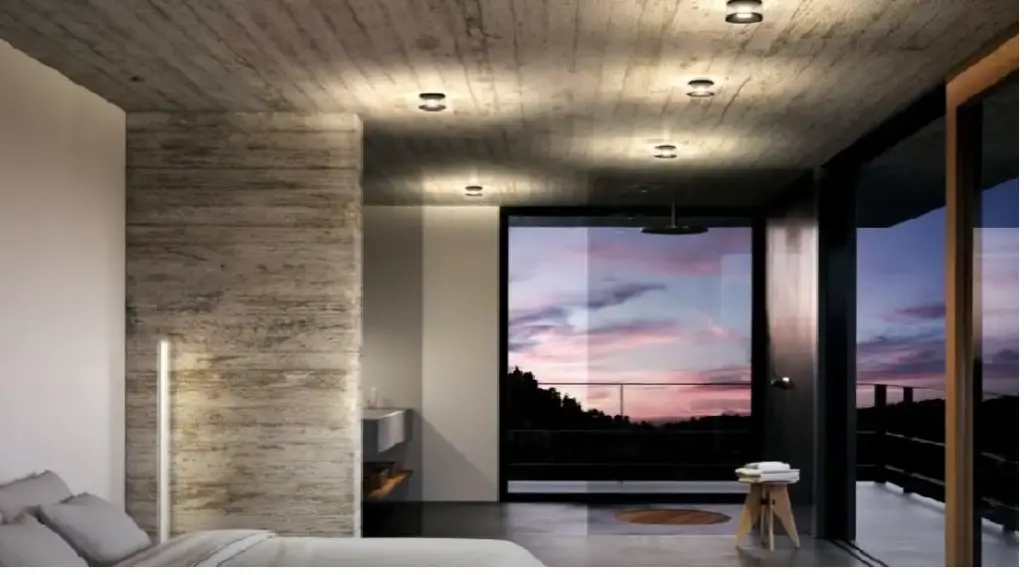
Overall, small bedrooms can be both practical and beautiful. By taking advantage of the unique features that they offer, you can create a space that is perfect for any occasion. With some careful planning, your small bedroom can become a cozy oasis!
How do you plan lighting in a small bedroom?
Lighting can be a tricky element to plan in a small bedroom. Depending on the size of your room, you may need to consider different options for creating comfortable and functional lighting.
One option for small bedrooms is task lighting. This type of lighting focuses on providing light where it’s needed most, such as over a reading chair or desk.
A good choice for task lighting is usually LED strip lights or wall mounted sconces near any work areas in the bedroom.
Accent lighting is also great for small bedrooms. Accent lights are used to highlight certain features of your bedroom, such as artwork or furniture. Examples of accent lighting include recessed lights, wall sconces, and floor lamps. These types of lighting should be used sparingly so that the bedroom doesn’t become too bright or overwhelming.
Finally, general lighting can provide a sense of balance to any small bedroom. General lighting is usually provided by overhead fixtures such as chandeliers, pendants, and ceiling fans with lights. This type of lighting serves the overall purpose of providing illumination throughout the entire room and should be chosen carefully to ensure it does not overwhelm the space.

Overall, planning lighting for a small bedroom requires careful consideration to create a comfortable atmosphere without overwhelming the space with too much light or darkness. A combination of task, accent, and general lighting can provide a good balance to any small bedroom.
Types of lightning in a bedroom
Lightning in a bedroom can be divided into two main types: ambient lightning and task lightning.
Ambient lighting is the kind of light that fills an entire room, providing general illumination to make it easier to navigate and do basic tasks like getting dressed or using the bathroom. It often comes from overhead lights, wall sconces, floor lamps, or recessed fixtures. The goal of ambient light is to make the space feel inviting and comfortable without being overly bright.
Task lighting provides focused light for specific activities like reading or doing makeup. This type of light usually comes from table lamps, desk lamps, picture lights, or pendant lights. Task lighting should be directed at whatever you need to see clearly but still remain pleasant to look at.
You should also consider how much natural light comes into your bedroom. Natural light not only looks beautiful but can also provide additional illumination in your space, reducing the need for artificial lighting during the day. Consider adding curtains or blinds that you can open or close depending on how much natural light you want in the room. This will ensure that you have ample light in your bedroom during the day, making it a warm and inviting space.
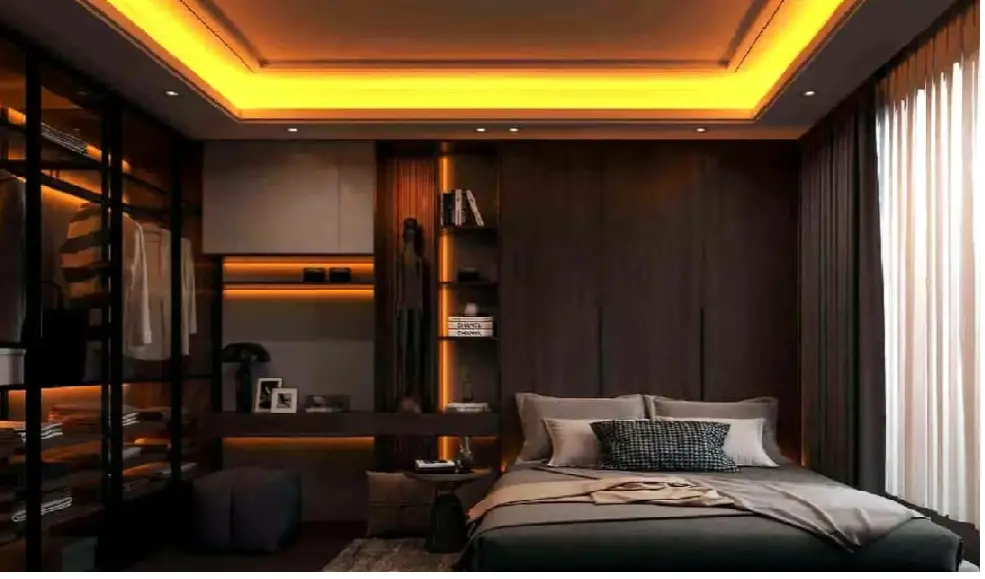
Finally, consider investing in LED lighting for your bedroom. LED bulbs last longer than other types of light bulbs and require less energy to operate, so you’ll save money on electricity bills over time. Plus, they come in a variety of colors and styles that can add an extra touch of charm to your bedroom.
Small bedroom lighting ideas
Save space with hanging pendants
Hanging pendants are a great way to save space in small bedrooms. Not only do they provide light, but they also add style and texture to the room. Look for unique shapes and materials that fit with your bedroom’s design aesthetic. Plus, you can use them as a focal point in the room.
Create unity by using the same accent color
If you want to create a cohesive look in your small bedroom, use the same accent color throughout. Pick one color and use it for wall art, bedding, lamps, curtains, and other accessories. This will help to tie the room together while still keeping it looking polished and pulled together.
Mix and match lighting sources
When you have limited space in your bedroom, mix and match different types of lighting sources. Table lamps and wall sconces can provide ambient light for reading or relaxing in bed. Floor lamps are also a great option for adding height to the room without taking up too much floor space. For task lighting over a desk or workspace, consider using a swing-arm lamp that can be easily adjusted when needed.
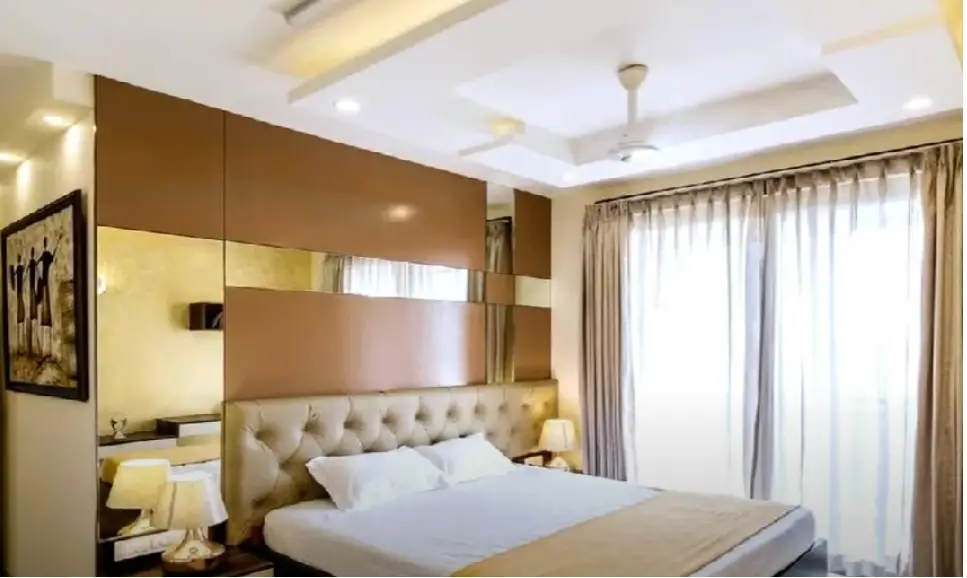
Hand an oversized paper pendant
An oversized paper pendant can provide a great source of ambient light in any small bedroom. Look for ones with unique shapes and patterns, or even materials like bamboo or rattan. You can hang it from the ceiling to make a statement or use it as an abstract art piece in the room.
Prioritize form and function
When it comes to lighting in any small bedroom, you have to prioritize both form and function. Choose pieces that look great but also provide the illumination you need. Think about how you will use the room and what kind of light your activities require before making a selection. This can help you find pieces that suit both your style and your needs.
Go LED
If you want to save energy while still getting bright lighting, opt for LED fixtures. LED lights are energy-efficient and long-lasting, so they’re perfect for small bedrooms where space is limited. Plus, many modern designs come with integrated dimmers so you can adjust the brightness when needed.
Invest in space-saving pendants
When space is tight in a small bedroom, look for pendants that can be hung from the ceiling without taking up too much room. Look for ones with adjustable arms to help focus light in specific areas, or opt for mini-pendants that provide plenty of illumination without sacrificing style.
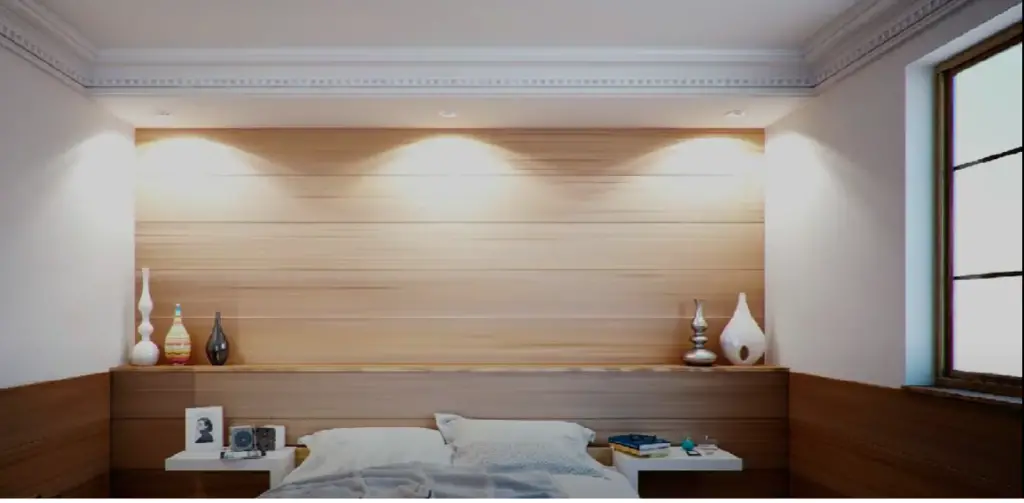
Choose a table lamp that blends with your nightstand
Table lamps are essential for any small bedroom. Look for ones that blend with the style of your nightstand, from classic to modern. You can also opt for a multi-socket lamp so you don’t have to worry about switching it on and off or finding extra outlets when you need more light.
Go for battery-operated wall sconces
If you want to add ambient lighting without taking up too much space, consider battery-operated wall sconces. They come in a variety of styles and materials, but they all provide plenty of illumination without having to be hardwired into the wall. Plus, they’re easy to install – all you have to do is hang them up and turn them on.
Create a cozy corner with string lights
String lights can be hung along the walls of your bedroom to create a cozy corner that’s perfect for relaxing or reading. Look for ones with different color settings so you can match them to your room’s decor, and get creative with how you hang them up. You can even use them as an unexpected way to display artwork or photos.
Add natural light
Make sure to take advantage of any natural light that might be available in your bedroom. Open the curtains during the day, and you may find that you don’t need artificial lighting at all! Natural light is also great for improving your mood, so it’s something worth investing in.
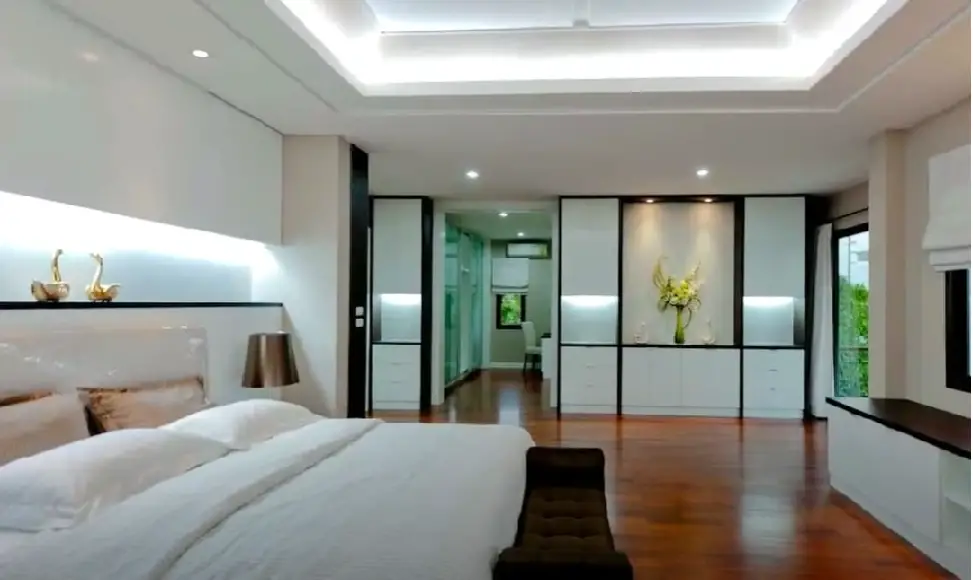
Source a vintage-style chandelier
If your small bedroom is feeling a bit too cramped, you can add some extra style with a vintage-style chandelier. Look for ones with an antique finish and intricate details that will help give the room more character. It’s also a great way to make the most of limited space without sacrificing style.
Opt for oversized table lamps for impact
If you want to make a statement with your lighting, consider oversized table lamps. Look for ones that are large enough to make an impact but still fit on the nightstand. You can also opt for unique designs and shapes, like globes or geometric patterns, to add some extra character to the room.
Incorporate task lighting
Task lighting is key in any small bedroom – it helps you focus when you’re reading or studying without creating too much of a distraction. Choose floor lamps that have adjustable arms so they can be moved as needed, or opt for desk lamps with integrated USB ports to help keep devices charged up while providing plenty of light.
Consider slimline with a touch of symmetry
When it comes to lighting a small bedroom, slimline fixtures offer the perfect amount of symmetry and style. Look for linear wall sconces that can be installed above each side of the bed, or opt for overhead ceiling lights for a more modern look. The possibilities are endless – just make sure to do your research and find pieces that fit both your space and your budget [1].
How to attach lighting for a small bedroom?
Attaching lighting to a small bedroom can be tricky, but it doesn’t have to be! With the right planning and creative ideas, you can create a beautiful and unique space with the perfect lighting. Here are some tips on how to attach lighting to a small bedroom:
- Choose the Right Size Fixture – You want fixtures that will fit in your space without overpowering it. Make sure that when measuring for light fixtures you take into consideration any other furniture or features in the room that may interfere with the placement of lights.
- Get Creative – Don’t limit yourself to traditional overhead fixtures; instead, think about ways to use table lamps, wall sconces, and floor lamps as well. These types of lighting can help create a bright and inviting atmosphere while adding a unique touch.
- Consider Task Lighting – If you plan on using the bedroom for tasks such as reading or studying, consider task lighting to provide focused light in specific areas. This type of lighting helps avoid eye strain when working on projects in the bedroom.
- Layer Your Lighting – Layering your lighting with different fixtures can also help provide enough illumination for a small bedroom space. You may want to use dimmers as well so that you can adjust the brightness levels depending on the time of day or task at hand.
- Make Safety a Priority – When attaching any kind of lighting fixture it’s important to make sure it’s securely fastened and won’t pose a hazard or be easily knocked over. Make sure you read the installation instructions carefully and follow all safety guidelines for proper installation.

With these tips, attaching lighting to a small bedroom can be done in no time at all! Be creative and have fun with your lighting design – you may just find it easier than you think!
How do you make a small room look bigger with light?
Lighting plays an important role in making a small room appear larger. With the right kind of lighting, you can visually expand the size of a room and create an illusion of more space. Here are some tips to maximize the effect:
- Choose bright colors for walls and other surfaces such as curtains or carpets. This will reflect light and make the walls look brighter.
- Use ceiling lights to draw eyes up towards the higher part of the room, giving it a taller appearance. Recessed lights are also great for this purpose.
- Include several layers of light from different sources, including floor lamps and wall sconces, to create texture and dimension in your lighting design.
- Add a mirror to reflect natural light. Place the mirror opposite a window or near a lighting fixture to create an even brighter effect.
- Incorporate task lighting in areas where you need more illumination for activities such as reading and writing. This will add functional light and brightness to the space.
- Install dimmer switches so that you can adjust the amount of light in the room depending on your mood. Dimmer lights will also help keep energy costs low.
Following these tips will help make your small room look bigger with just the right kind of lighting [2]!
Where should lights be placed in a small bedroom?
When choosing where to place lighting in a small bedroom, it is important to create enough light for the space without making it seem too bright.
Finally, take advantage of natural light whenever possible by incorporating sheer draperies that let sunlight in during the day but still provide adequate privacy at night. This will help reduce the need for artificial lighting, as well as create a more inviting atmosphere in the room.
FAQ
What is the best lighting for a small bedroom?
The best lighting for a small bedroom depends on its purpose and use. If the bedroom is primarily used for sleeping, then soft, adjustable lights that can be dimmed are ideal. For tasks such as reading or dressing, try using task lighting such as clip-on desk lamps that focus light in one area at a time. You may also want to incorporate floor lamps with adjustable arms so you can direct light where it’s needed most. Ceiling lights should be avoided if possible since they tend to create too much brightness in smaller areas. Finally, adding a few layers of ambient lighting throughout the room can really help make it feel cozy and inviting.
What type of furniture should I choose for a small bedroom?
When selecting furniture for a small bedroom, look for pieces that are both functional and stylish. Avoid large pieces with bulky designs and opt instead for multi-functional furniture like daybeds or ottomans that can be used in different ways. Also, consider using storage space such as under the bed or built-in shelving to maximize available space. Finally, when possible, choose lighter colors and fabrics to help open up the room.
How do I make a small bedroom look bigger?
A few tricks can help make a small bedroom appear larger than it is. To create more space, place mirrors strategically around the room to lend an illusion of depth. Using light colors in both your walls and furnishings will also reflect more light, making the room appear bigger. Finally, adding vertical storage to your walls will help you to conserve floor space and make the most of available wall space.
How do I light a bedroom wall?
Lighting a bedroom wall depends on the type of lighting you want to use. For an ambient effect, try using indirect lighting or wall sconces placed up at eye level. If you are looking for task lighting, then spotlights or adjustable track lights will work best. Finally, consider installing dimmable LEDs under shelves and in cabinets to help create an even more inviting atmosphere.
What type of bedding should I choose for a small bedroom?
When selecting bedding for a small bedroom, go with lightweight materials such as cotton or linen that won’t weigh down the room. Choose lighter colors to keep the space feeling airy and bright and add texture with throws and accent pillows. Finally, make sure to select sheets that fit snugly to the bed so it appears more streamlined.
How can I add light to my bedroom with no windows?
Adding light to a bedroom with no windows can be done in several ways. Skylights are an ideal solution for bringing natural light into the room but if this isn’t possible, then opt for artificial lightings such as floor lamps and wall sconces instead. Track lighting, recessed lighting, or LED strips can also be used along the walls or under cabinets to help brighten up the space. Finally, adding sheer curtains or window treatments will also help bring in more ambient light.
What is the best way to arrange furniture in a small bedroom?
When arranging furniture in a small bedroom, try using pieces that have multiple purposes like an ottoman that doubles as storage space. If you’re tight on space, look for pieces that can be easily moved and tucked away when not in use. Also, create a focal point with a bed or dresser by pushing it against the wall and then placing the rest of your furniture around it. Finally, if possible, allow yourself some walking space between furniture pieces to keep the room from feeling cramped.
How can you increase light in a room without natural light?
If a room doesn’t have natural light, then it’s important to make full use of artificial lighting. Start by using brighter bulbs and installing several layers of ambient lights throughout the space. Track lighting or recessed lighting can also be used along walls to help brighten up the area. Adding mirrors helps reflect more light and if possible, opt for sheer curtains or window treatments that allow some filtered sunlight in during the day. Finally, consider using LED strips under shelves and cabinets for discreet yet effective task lighting.
How many lights should be in a bedroom?
The number of lights in a bedroom depends on the type and size of the room. Generally, it’s best to have multiple layers of light with ambient, task, and accent lighting all working together to create the most inviting atmosphere. A good rule of thumb is to have three different types of light sources for each area in the bedroom. For example, place two wall sconces near the bed for ambient lighting, add a track or recessed lights for task lighting, and finish off with LED strips under shelves or cabinets for accent lighting.
How do I make my small bedroom look cozy?
Making a small bedroom look cozy starts with adding some warmth to the space. Choose furniture and decor in inviting colors like soft blues, greens, or yellows, and add throw blankets and cushions for extra comfort. Incorporate plants into the room as they can help bring life to a space while also purifying the air. Finally, pay attention to lighting and install dimmable LEDs or wall sconces that can be adjusted depending on your mood.
Useful Video: 17 Small Bedroom Lighting Ideas Low Ceiling For Your Home
Conclusion
Lighting in small bedrooms can be a tricky subject to tackle. However, with the right combination of ambient and task lighting, it is possible to find an arrangement that works well in any small bedroom. Investing in higher-quality fixtures can help create a luxurious atmosphere without taking up too much space. It is important to remember that the balance between light sources should be carefully considered when designing a bedroom to ensure comfort while also creating an aesthetically pleasing environment. With careful planning and thoughtful consideration, anyone can successfully achieve beautiful lighting in their small bedroom.
References:
- https://www.realhomes.com/design/small-bedroom-lighting-ideas
- https://www.idealhome.co.uk/bedroom/bedroom-decor/small-bedroom-lighting-ideas










Leave a Reply